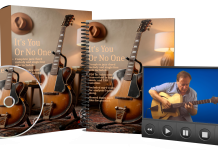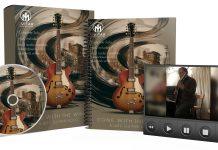This post may contain affiliate links. As an Amazon associate, Google associate as well as associate for other programs, Guitar & Music Institute may earn commissions from qualifying purchases.

Welcome to our guide on exploring different guitar playing styles! If you’re starting or already play guitar, this guide is for you. It will help you learn about various genres. We will look at fingerstyle, blues, and more, showing you the secrets of each style.
Learn about fingerstyle playing, plucking strings to make melodies. Then, get into blues guitar, with its deep history and cool techniques. Try out unique methods like alternative tunings and hybrid picking. These can make your music stand out. Whether you aim to lead or keep the rhythm, this guide has tips for all.
So, get your guitar ready, let’s tune up, and start exploring music together!
Key Takeaways:
- Explore different guitar playing styles to broaden your musical capabilities.
- Master fingerstyle playing and create intricate melodies with ease.
- Delve into the history and techniques of blues guitar.
- Experiment with alternative tunings and hybrid picking techniques.
- Develop your skills as a lead or rhythm guitarist.
Understanding the Foundation of Guitar Playing Techniques
As a passionate guitarist, you know getting better is key. Having a strong foundation in guitar techniques is vital. It helps you excel and shows your full potential as a musician.
Working on your technique is critical. Regular practice boosts your finger skills, speed, and accuracy. This lets you tackle complicated pieces smoothly. Mastering different picking styles adds to your skills.
Music theory is essential for all guitarists. It helps you understand scales, chords, and how music works. With it, you can work well with others and create your own tunes.
Learning the fretboard opens up new possibilities. You’ll discover new sounds by studying scales and intervals. This not only improves your playing but makes you more creative.
Playing songs from different genres is useful too. It sharpens your skills and introduces you to new ideas. You’ll appreciate other music styles more.
Benefits of a Strong Foundation
Putting effort into your skills, music theory, the fretboard, and learning songs builds a strong base. This foundation is crucial for playing any music style. It helps you adapt and grow as a guitarist.
With a solid foundation, you can confidently explore and create. Keep learning and practicing. Watch your guitar skills reach new heights.
Discovering the Roots of Blues Guitar
Blues guitar is key to many modern music styles. Its deep history and emotional sounds have touched genres like rock and jazz. To master blues, learning its origins and techniques like slide guitar is vital.
The story of blues guitar is tied to the African American fight for freedom. It started in the Mississippi Delta in the late 1800s. Blues influences shaped American music, with stars like Robert Johnson leading the way.
Blues music split into two main styles: Chicago blues and Texas blues. Chicago blues came about as African Americans moved North in the early 1900s. This style is known for its electric sound, with Muddy Waters as a key figure.
Texas blues has a unique sound, mixing various musical traditions. Stars like Lightnin’ Hopkins made Texas blues famous worldwide with their intense guitar skills.
Slide guitar uses a glass or metal slide for a special sound. This technique is seen in the music of legends like Duane Allman.
Fingerstyle lets guitarists play complex tunes with their fingers. It’s a must for playing blues well. This style is featured in the songs of Robert Johnson and Blind Blake.
Learning about blues guitar’s history and styles enriches your music knowledge. Whether you’re starting out or expanding your skills, the blues offers great opportunities for growth and expression.
Delving into the Sophistication of Classical Guitar
Classical guitar is more than just music; it’s an art that showcases beautiful fingerstyle play. You’ll find richness in learning from composers like Fernando Sor and Johann Sebastian Bach. They help you grasp the true beauty of classical guitar.
This genre brings out the pure sound of the guitar. Your fingers will craft captivating tunes. Mastering the fingerstyle technique is key, as it demands accuracy and control.
Getting into classical guitar lets you see the greatness of its composers. Their work ranges over centuries, filled with technical and emotional depth. You’ll encounter everything from Sor’s reflective pieces to Bach’s intricate compositions.
Learning classical techniques like arpeggios and tremolo adds depth to your play. These methods help you blend melodies, harmonies, and bass lines perfectly. It’s like painting with sound.
Learning from the Masters
Studying classical composers reveals a lot about guitar art. Fernando Sor introduced groundbreaking techniques, including the slur. These are central to today’s classical guitar music.
Johann Sebastian Bach, with his work for lute and keyboard, is crucial for guitarists. His fugues and preludes offer a blend of complexity and challenge. They’re key for anyone serious about classical guitar.
To really excel in classical guitar, learn from the pros. Good teachers and seasoned performers can guide you. Their knowledge is priceless for mastering this genre’s nuances.
Remember, becoming a classical guitarist is a journey. It’s about discipline, patience, and love for the genre’s elegance. Your explorations in classical guitar will unlock a universe of musical paths. You’ll get to interpret timeless pieces in your own style.
Navigating the World of Jazz Guitar
Jazz guitar is unique for its freedom to improvise and the various styles it includes. From swinging classics to quick bebop and lively Latin jazz, it offers a world of expression for musicians.
To master jazz guitar, understanding its basic elements is key. One major element is jazz chords. These chords are complex and full of texture. They bring color and distinct sounds to your playing, making your music uniquely jazz.
Another important aspect is jazz scales. These scales are crucial for improvisation and melody. By learning major, minor, dominant, and altered scales, you can handle jazz guitar’s complex harmonies.
Ever heard of swing? It’s a core jazz style known for its catchy offbeat rhythms. Swing is the heart of jazz music. Learning to play swing rhythms is essential for a true jazz sound.
Bebop is another jazz style you’ll come across. It features quick tempos and complex chords. Bebop will test your technical abilities and encourage you to play elaborate melodies and arpeggios.
For a dose of Latin excitement, try Latin jazz. It blends Afro-Cuban beats with jazz’s spontaneous sounds, creating energetic music. Bossa nova and samba will introduce you to a new, lively musical world.
Key Points:
- Jazz guitar is known for its improvisational nature and diverse styles
- Mastering jazz chords and scales is crucial for playing this genre
- Swing, bebop, and Latin jazz are prominent styles within jazz guitar
- Understanding swing rhythms and bebop techniques enhances your jazz guitar skills
- Exploring Latin jazz adds a vibrant and rhythmic element to your playing

Rocking Out with Rock Guitar
Rock guitar is all about power and energy. This genre shines with powerful riffs, electrifying solos, and memorable performances. Learning certain techniques is key to mastering the rock sound.
Power Chords
Power chords are essential to rock guitar. They are three-note chords that deliver a heavy, aggressive sound. By focusing on the root note and the fifth, these chords bring raw energy to the music. They ground the rock anthems we love.
Palm Muting
Palm muting adds control to your play, a must-know technique. It involves lightly touching the strings with the palm edge while you pick or strum. This creates a muted, percussive effect. It’s especially popular in heavy rock and metal to give the guitar a rough edge.
Guitar Solos
A great rock song always has an epic guitar solo. These solos show off your skills, creativity, and storytelling through music. Fast or melodic, solos are key to rock and captivate listeners.
Rock Legends
We can’t talk rock guitar without mentioning legends like Jimi Hendrix and Jimmy Page. Their groundbreaking work defined rock’s sound. Studying their music offers priceless inspiration and insight into rock guitar.
To truly excel in rock guitar, be passionate and dedicated. Learn the genre’s history and techniques. Using power chords, palm muting, and guitar solos will bring that iconic rock sound alive. This sound moves people and defines the genre.
Exploring the Grooves of Funk Guitar
Funk guitar is all about groove and rhythm. If you want to play the funkiest tunes, learn rhythmic strumming and try styles like chicken pickin’. These skills will let you produce beats that everyone wants to dance to.
Using rhythmic strumming is key in funk guitar. It means playing in a tight, percussive way that matches the band’s beat. This style makes a syncopated, powerful groove typical in funk tunes. Whether playing softly or adding funky touches, this technique is crucial.
Chicken pickin’ is also vital for funk guitar. It blends picking and plucking for a unique sound. This combo of techniques gives a sharp, staccato rhythm, adding a funky vibe to your music.
It’s helpful to learn from funk legends like Nile Rodgers and Eddie Hazel. Nile Rodgers, famous for his time with Chic, is a rhythm guitar genius. His riffs are some of the most memorable. Eddie Hazel brought innovative guitar skills and effects to Funkadelic. His work in funk rock is legendary.
So, if you want to dive into funk guitar, now is your chance. Work on rhythmic strumming, get into chicken pickin’, and be inspired by the greats. With commitment and practice, you’ll set the mood at any party.

Embracing the Heartwarming Sounds of Country Guitar
Country guitar brings heartwarming sounds and unforgettable tunes. It’s known for fingerpicking, hybrid picking, and twangy tunes. These styles paint a picture of vast landscapes and the simple life.
If you want to get into country guitar, start with fingerpicking and scales. Fingerpicking lets you weave complex tunes. Scales let you express yourself and improvise in country style.
Look up to legends like Chet Atkins and Brad Paisley. Their skill in creating emotion-packed tunes has shaped country guitar. Learning from them can help you find your unique sound.
Listening to various country songs helps too. It helps you see how country has changed and grown. You’ll discover different styles and stories within the genre.
Country Guitar Techniques:
- Fingerpicking: Here, you pluck strings with your fingertips for melodic patterns and rhythms.
- Hybrid Picking: This mixes pick and fingers picking for versatility and speed.
- Twangy Melodies: For the twangy sound of country, use bending, sliding, and alternate picking.
Dive into the world of country guitar and explore its tradition and stories. Pick up your guitar and let country music’s spirit flow through you.
Diving into the Intensity of Metal Guitar
If you’re ready to unleash your inner rock god, get set for an exciting journey! Metal guitar demands precision, speed, and powerful riffs that make your speakers quiver. It’s all about delivering those heavy, heart-pounding sounds.
Mastering key techniques is a must in metal. One key skill is sweep picking. This lets you play fast arpeggios smoothly. With dedicated practice, you’ll nail those incredible solos and complex melodies that metal is known for.
Tremolo picking is another vital technique. It involves fast switching between notes for a fierce sound. With practice, your hand will get stronger and more precise, keeping up remarkable speed and accuracy.
Metal is known for its heavy, bone-crushing riffs. Palm-muted chugging gets you that strong, rhythmic sound. Rest the edge of your palm on the strings and pick hard. This creates the aggressive tone that defines metal.
We can’t talk metal without mentioning its pioneers like Black Sabbath and Metallica. They’ve inspired many with their sound and songs. Learning from them can spark inspiration and deepen your metal guitar skills.
Understanding metal guitar means diving into the music. Explore different styles and put your own spin on them. Metal is about breaking the mold, being creative, and delivering show-stopping solos.
Are you ready to embrace the intensity of metal guitar? Here are some key takeaways to keep in mind:
- Master techniques like sweep picking, tremolo picking, and palm-muted chugging for precision and speed.
- Draw inspiration from metal pioneers like Black Sabbath and Metallica.
- Immerse yourself in the diverse sub-genres of metal to expand your musical horizons.
- Unleash your creativity and develop your own unique style within the realm of metal guitar.
Up next, we’ll explore the beauty of fingerstyle guitar. We’ll cover fingerpicking patterns, chord tricks, and styles. Get ready to create stunning melodies with just your fingertips.
Discovering the Intricacy of Fingerstyle Guitar
Fingerstyle guitar is a versatile style that lets you create complex tunes and rhythms. You use your fingers to play. This way, you can mix melody, harmony, and basslines smoothly.
Learning fingerpicking patterns is key in fingerstyle guitar. You pluck strings one by one with fingertips or nails. This brings a rich sound. Patterns can be simple arpeggios or mix percussive elements with melody.
Chord embellishments also matter a lot. They add color and depth to chords, making music more expressive. Techniques like hammer-ons, pull-offs, and slides help do this.
Fingerstyle guitar fits into many music genres. Take folk, blues, and bossa nova, for example. In folk, it lays the groundwork for stories in song. Blues gets more soulful with fingerpicking. Bossa nova benefits from its smooth, rhythmic style.
This image shows the elegance of fingerstyle guitar. It highlights the skill needed for fingerpicking and chord tricks.
Exploring fingerstyle guitar opens up lots of creative paths. It’s all about blending different musical layers in your own way. Both newbies and seasoned guitarists can grow their skills through it. Fingerstyle guitar makes your music rich and deeply personal.
Unleashing the Beauty of Brazilian Guitar
The Brazilian guitar offers a captivating musical journey. Its most famous style is bossa nova, known for smooth melodies and cool rhythms. To really get the Brazilian guitar feeling, it helps to learn about its special techniques and instruments.
Brazilian music often uses nylon-stringed guitars. These guitars produce a warm and mellow sound. When you combine nylon strings with the unique strumming patterns, you get a beautiful mix of melody and rhythm.
Learning rhythmic strumming is key to mastering Brazilian guitar. The rhythms in bossa nova are complex and syncopated, which makes the music groovy. Work on your strumming skills to truly capture the genre’s spirit.
Brazilian guitarists have made this genre famous worldwide. João Gilberto is one such master. His innovative playing and smooth singing helped shape bossa nova. His work continues to influence guitarists worldwide, enriching Brazilian guitar’s legacy.
To dive into the beauty of Brazilian guitar, start with bossa nova. Embrace its rhythm, try out nylon-stringed guitars, and explore the unique sounds that have charmed people for years.
Finding Your Unique Voice as a Guitarist
As a guitarist, creating your own musical journey is in your hands. You can discover a world of guitar creativity by trying different styles. Be it soulful blues, complex classical pieces, or funky rhythms, every genre has so much to offer.
Adding various techniques and influences to your music helps you stand out. Try mixing genres and borrowing from different styles to express yourself. It’s not about copying anyone. It’s about walking your own path and adding a personal touch to your music.
Let the magic of different genres inspire your guitar play. Look up to legends like Jimi Hendrix, Chet Atkins, or João Gilberto. Absorb their sounds, rhythms, and melodies and let them kickstart your creativity. The guitar offers a wide landscape for music, allowing you to mix genres and try out new techniques.
So, don’t box yourself into a single category or idea of what a guitarist should be. Explore all the possibilities. Let your passion for guitar lead the way to finding your unique voice. Consider all guitar genres as your playground and let your creative spirit fly.
FAQ
What are the different guitar playing styles covered in this guide?
This guide includes many playing styles. You’ll learn about fingerstyle, blues, classical, jazz, and rock. It also covers funk, country, metal, and Brazilian guitar.
What techniques are important for building a strong foundation of guitar proficiency?
To build a solid guitar foundation, focus on your technique. Learn music theory well, and explore the fretboard.
How has blues guitar influenced other music genres?
Blues guitar has shaped rock, jazz, funk, soul, and country. It’s crucial for understanding these styles.
What techniques are important for mastering classical guitar?
Mastering classical techniques and diving into classical composers’ works are key. They help you excel in classical guitar.
What techniques are essential for playing jazz guitar fluently?
For fluent jazz guitar, you must master chords, scales, and improvisation. These are vital techniques.
What techniques are important for creating a rock sound on the guitar?
For a true rock sound, learn power chords, palm muting, and alternate picking. These techniques are crucial.
What techniques are essential for embracing the funky side of guitar playing?
To get funky, focus on rhythmic strumming and chicken pickin’. These techniques are vital for funk style.
What techniques are important for capturing the heartwarming sounds of country music on the guitar?
Country music’s warmth comes from fingerpicking and knowing major and minor scales. These techniques are key.
What techniques are essential for playing metal guitar?
For metal guitar, master sweep picking, tremolo picking, and palm-muted chugging. These techniques are crucial.
What techniques are important for playing fingerstyle guitar?
Fingerstyle guitar requires mastering fingerpicking patterns and chord embellishments. These are important in folk, blues, and bossa nova.
What techniques are key to capturing the beauty of Brazilian guitar?
Brazilian guitar’s beauty lies in mastering rhythmic strumming and bossa nova patterns. Playing on a nylon-stringed guitar is key.
How can guitarists develop a unique voice and expand their musical palette?
Guitarists can find their unique voice by exploring different styles. Using various techniques and influences helps expand their music.
Source Links
- https://college.berklee.edu/guitar/news/guitar-playing-styles-to-explore-and-master
- https://colchesterguitarteacher.com/2023/08/03/exploring-different-guitar-genres-a-guide-for-guitarists/
- https://nationalguitaracademy.com/finger-picking-styles/
This post may contain affiliate links. As an Amazon associate, Google associate as well as associate for other programs, Guitar & Music Institute may earn commissions from qualifying purchases.


























